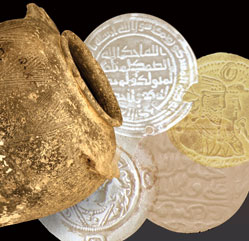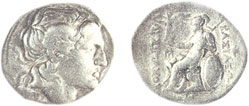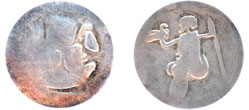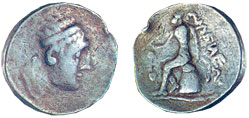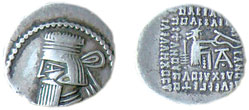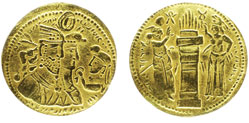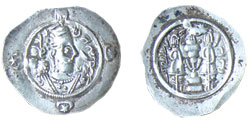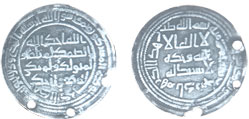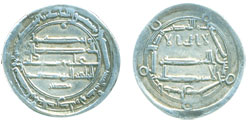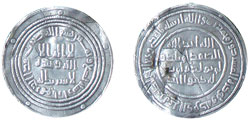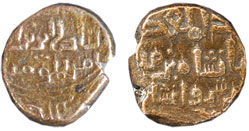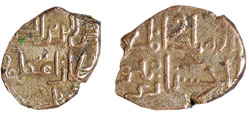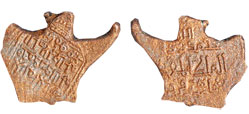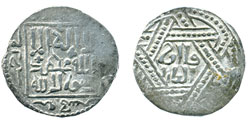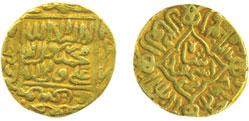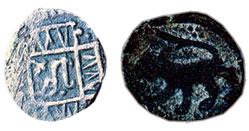The coins that we take for granted in our pockets and purses will be valuable source material for historians in a few centuries’ time. The images stamped on them convey the values of the issuing state or region. The presence of foreign coins in a country is evidence of trade and travel links, or even invasion. A wealth of coins has been found in Azerbaijan, some of them the result of its location on historic north-south and east-west trade routes, such as the famous Silk Road. Historian Ganira Pirguliyeva reveals some of the stories Azerbaijan’s coins have to tell.
One of the earliest references to coins in Azerbaijan can be found in the work of ancient Greek historian Herodotus. Writing in the 5th century BC, he said that two centuries earlier King Achaemenes of Persis had received 200 talents (about 20 tons) of silver from the Caucasus every year in tax.
Another century later, the people in what is now the Azerbaijan Republic were using drachmas issued in the empire of Alexander the Great in their trade with other nations. This is testament to Alexander’s power and influence, as the land was not part of Alexander’s empire. Substantial quantities of these coins have been found in Azerbaijan over the past 200-250 years.
Coins minted during Alexander’s rule were in circulation for 300 years after his death. As though his subjects could not believe that he was gone, coins with Alexander’s likeness continued to be minted across the disintegrating empire. These “barbarian” coins were first minted after Alexander’s death in the territory of Azerbaijan in the 3rd century BC and were widely used for a century in Caucasian Albania, a state that covered much of modern-day Azerbaijan (Figs. 1-3). The coins were minted in the capital city of Albania, Qabala, and in Shamakhi. These exquisite samples must have circulated only in Caucasian Albania, as they have not been found in other parts of the empire. Large tetra-drachmas and medium-value drachmas minted in the name of the current ruler and with his portrait remained currency in all the territories of the empire, but on the periphery, in the outlying districts, people were comfortable using the false coins in their commerce. These “barbarian” coins, albeit in small quantities, remained valuable currency in the country for a hundred years until the emergence of the Parthian Empire (mid-3rd century BC).
When coins were gold
Coins of the Seleucid state, which emerged on the territory of much of Alexander the Great’s empire, were in vogue in foreign trade, namely in the market towns on the ancient trading routes. As the Seleucid and Parthian empires vied for power, Caucasian Albania fell unofficially under the Parthians’ sphere of influence. As a result Parthian coins (Fig. 4) were used to buy and sell all kinds of imported fabrics, jewellery, clothing, dried fruits and other goods. Gold, silver and copper versions of these coins have been found in Azerbaijan. The demand for coins was so great that during the reign of Mithridates II (123-88 BC) skilled minters in Caucasian Albania produced fake coins. The profits to be gained from counterfeit coins must have made it worth running the risk of the severe penalties imposed for minting fake coins.
The main indicator of a state’s strength and depth was the economic growth of its cities. By the early Middle Ages, Nakhchivan, Ganja, Baku, Derbent and other cities were known for the variety of commodities they produced. From the middle of the 3rd century they formed a province of the Sassanid Empire, whose rulers were very aware, and wary, of the Caucasus as a border zone. Thus the Sassanids spent valuable time building long barriers – walls castles and towers – as grand and strong as the Derbent-Beshbarmaq Mountain and Balakan-Zaqatala-Qakh defensive lines to ensure control of the ancient silk trade routes, collect taxes from traders, keep out foreign currency and end the claims of Turkic tribes to these routes.
Sassanid money was the only currency within the Sassanid Empire. To be more precise, from the reign of Shahanshah Qubad (also known as Kavadh, 488-531), well-established cities were allowed to mint coins carrying the first three consonants of their names (Figs. 5-6). These coins were accepted across the empire and valued equal to coins minted for the whole territory and central cities. In other words, one could buy and sell goods of the same value everywhere in the empire using coins minted in Derbent, Ganja and Baku. This was actually a great advance in our history and indicated the significance of our cities. Not every city achieved that status in the empire of those times. The penalties for unauthorised minting were severe indeed. To obtain the right to mint coins a city had to have craftsmen able to do it, the metals and, most importantly, they had to be trade centres on international routes. This revival lasted for about 200 years.
Sassanid meltdown
With the emergence of the Arab Caliphate, coin minting ceased for about 100 years because the main battles in the wars between the Arab, Byzantine and Khazar states were fought on these lands. However, the Sassanid coins minted in earlier centuries remained in circulation. For the first time people were forced to use Byzantine hexagrams, gold shell-shaped solids and folles made of copper, each one a work of art due to the images they bore, in markets and on trade routes. But the coins were alien to people’s religious beliefs and they were not circulated widely. Coins brought by foreigners from the Byzantine Empire to the borders are mainly found as buried treasure or chance finds. It is interesting that Byzantine coins are found more frequently on lands below the Kura River. Very few of them are found to the north of the river; finds here are usually coins patterned with “arz-az-khazar” printed in Arabic script and minted mostly in the Khazar khanate, in small quantities. At-Tabari wrote that the Arabs knew the work of minting and were familiar with money prior to their acceptance of Islam. This is quite convincing. The fact that Prophet Muhammad (pbuh) traded for many years as head of a caravan supports At-Tabari. Of course, the occupation of Sassanid lands and Byzantium under the flag of Islam was the Arabs’ main strategy. There were campaign battles in the Caucasus at intervals for up to 100 years. As the Caliphate battled to fully occupy the ancient trading routes the Arabs minted no new coins.
A long-term monetary reform was finally implemented by Caliph Abd-al-Malik and was a landmark in the building of states for eastern countries, as it had been for the west; it seemed the world had turned on its axis. Sassanid currency was removed completely from circulation. It was forcibly collected and sent to the treasury to be re-minted. Some resisted and buried the beautiful coins, relying on the value of the silver. These are the treasure troves still being discovered in many parts of the world.
The dinar – from image to script
The Arab gold dinars, silver dirhams and copper fulus may not seem so very different from the drachmas and folles of the ancient world, but their image and concept were in sharp contrast. These coins were no longer symbols of extravagance and philosophical ideas. No living thing, no ruler’s portrait, was stamped on them. Usually there were verses from the Holy Koran, as well as the official name of the caliph, sometimes his whole name, and the place and date of minting were printed in various styles and methods (Figs. 7-9). Even though “Muslim coins” appeared to be very simple compared with those used in Azerbaijan before Islam, they are still regarded as particular examples of the art and valuable for the texts on both sides.
The official language of the state and religion, as well as the ruler, was embossed on coins with special skill; Arab coins maintained this tradition and moved from ideograms to script. Thus, everything was clearly shown on the money; it was no longer necessary to puzzle over who was shown in an image. The Arabs printed the full name of the ruler together with his titles, as well as the main religious principle – “there is no God but Allah” – on the ineradicable seal.
Under Arab rule, from 12 to 36 trading cities within the present-day Azerbaijani area had permission to mint; via trade these coins spread throughout the Caliphate. The names of the cities Barda, Jar and Ganja appeared on coins minted at this time. The Arabs were the first to issue coins with the toponym Azerbaijan. They were minted in Ardabil (now in Iran).
There were so few changes in weight, round shape and design – a crescent moon and symbols of state and religion – that it can be difficult to distinguish them. Thus, by Islamic law, each coin weighed 1 misgal, 4.25 grams, accurate to between 0.01 and 0.05 milligrams. This is an indicator of a strong state and sound economy.
From crisis to renaissance
However, later unrest and the creation of new, smaller states on the lands conquered by the Caliphate were reflected in a reduction in weight of the coinage. The weakening of the Abbasid Caliphate exacerbated these tendencies and new states emerged, which started to mint their own coins. They did not change much the traditions of “Muslim coins”; they simply added, on both sides, the names of local rulers together with the caliph’s name. The cities in these states also began to develop so well that merchants from foreign countries, including emerging European countries, traded for silver coins alongside other commodities. This was their introduction to money. At first they took these artistic coins, relatively light but high in value, as jewellery, bought them up and took them away. This process caused a silver coin “crisis” in eastern states; however, this in turn may be said to be the origins of a renaissance in Muslim countries.
In the area of Azerbaijan the Shirvanshah, Salari, Ravvadid and Shaddadid states were at the forefront of this renaissance. Evidence of the states’ economic growth at the time lies in the collections of their silver coins held in the world’s museums (Figs. 10-12). The 10th century Sajid state, which ruled much of present-day Azerbaijan and Armenia, minted coins independently from both gold and silver.
The silver coin “crisis” and development of minting skills led to the production of coins made of non-precious, non-ferrous metals and the idea of credit – these sim and dirham coins “temporarily” replaced the solid silver ones. Thus a measure taken to discourage the export of silver coins marked an interesting stage in the history of the economy, especially for orthodox Islamic countries. The first germs of the Muslim-Turkish renaissance began from the artistry of the coinage industry and spread to architecture, literature and science. This renaissance began 500-600 years before that in Europe and lasted up to 200 years. Chemical metrological studies of the composition of the coins minted in Azerbaijan confirm their origin within these 200 years.
The Mongols and monetary rescue
The renaissance had finished before the Mongol invasions of eastern countries and few coins were minted between 1225 and 1256-58. In some areas people were forced back to a subsistence economy. The Hulagid state that emerged after the third Mongol invasion re-established the practice of minting coins (Fig. 13) but with innovations. The Mongol-Turkic coins incorporated features to prevent counterfeiting and Uighur–Mongolian-Turkic words began to appear along with animal and botanical features.
Not all the innovations came from the Mongols. Images of riders and weapons had already been introduced to coinage during the Seljuk era. The Mongols carried on this tradition and developed it further.
However, an innovation by Mongol Sultan Oljaytu (ruled 1304-17) has proved to be useful historical evidence. His silver coins bore a key Shia phrase, “Aliyyan Valiyullah”, and the names of the 12 imams. These coins show it to be a misapprehension that the Safavids were first to adopt Shiism as the state religion. Shiism began to be recognised under Mongol rulers in the 13th century, 200 years before the Safavids.
The Mongols also replaced the Arabic names of the currency. The large six gram silver coins were called tanga and the three gram silver coins were called miri. For them the tamga (seal) represented the property of the state. And so names like tamga, temge and tenge related to the largest units of currency, which were minted in about 30 cities and residential areas of military importance. And the Mongols then first leased out work in the economy, but only issuing the right to mint copper coins. This was to avoid dissatisfaction, ensure domestic supply and to guarantee payments to soldiers during long battles and wars by minting in camps if necessary.
The appearance of various animal characters on copper fulus was in fact a return to totemism – to the ancient faith of the Turks. Thus, every city had its symbol or coat of arms: the lion and the fish for Baku, the horse for Shamakhi and an image of the sun like a woman’s face on the back of a lion moving to the right for Mahmudabad (named to honour Mahmud Qazan Khan after he accepted Islam, the city lay between the modern-day towns of Salyan and Neftchala and was later submerged beneath the waters of the Caspian Sea). Thus the coinage as an attribute of the state bore its symbols. This innovation was widely adopted.
Coins as symbols of state
The Safavids (ruling from 1501) rejected the currency they inherited. Dispensing with images of living beings, they reverted to classical Muslim coinage, adding poetic text. Coins were minted in all the significant cities of the empire, some in gold, but mainly silver and copper. These coins, especially from later Safavid rulers, were of high quality, some weighing up to 12-14 grams.
Holding an abbasi or shahi coin, one can feel the weight of one of history’s most powerful empires. A coin embodies and imparts information about the religion, the head of state and his titles, the name of the city where it was minted, as well as the history of minting. It could praise battles and personalities, give the sayings of Hazrat Ali, poems devoted to him and other wise words. There have been no other coins like these in the history of the east (Fig. 14). The shahi and abbasi are still referred to in Azerbaijani as metaphorical estimations of something’s worth or cheapness.
The ten-year Afshari state, from 1736, issued coins called nadiri after the ruler Nadir Shah. Coins of the state, which extended from Kabul up to Bukhara and Derbent, were minted under the name of Azerbaijan. Unfortunately, research into the coinage and economy is still incomplete.
The Qajar dynasty (ruled from 1785) issued coins but went almost bankrupt and for the last 50-70 years of their existence the Azerbaijani khans minted mainly copper coins, which circulated only within the khanates (Fig. 15).
Following occupation by the Russian Empire until 1918 Azerbaijan was part of the “rouble zone”. The Azerbaijan Democratic Republic (1918-20) issued paper currency, which was called the manat in Azerbaijani and rouble in Russian. The notes were inscribed in Azerbaijani in Arabic script and in Russian. Larger denominations also had script in French, the international language of the time. No small coins were issued. This was probably due to lack of time and the tense political, military and economic situation. In the Soviet era, Azerbaijani currency was gradually removed from circulation and the rouble replaced it. Following the collapse of the Soviet Union and the restoration of Azerbaijani state independence, the manat was restored to the country.
About the author: Ganira Pirguliyeva, PhD History, is a numismatist and chief scientific officer of the Scientific–Cultural Centre of the Icheri Sheher (Inner City) State Historical-Architectural Reserve. She is the author of two books, four monographs and 60 scientific articles and founder of the first numismatic exhibition in Azerbaijan.
